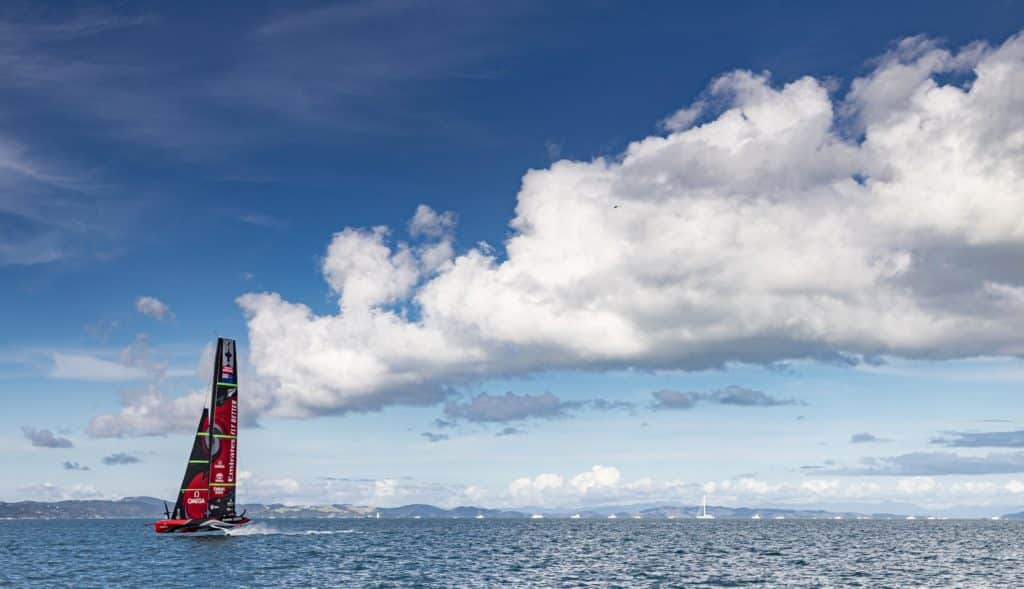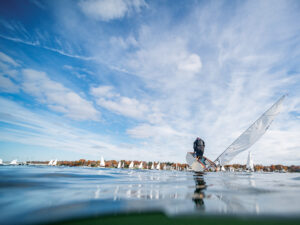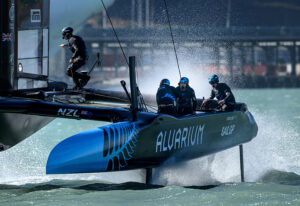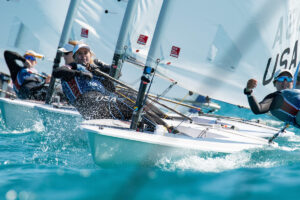
At some point during the press conference following a mind-bending Race Day 5 of the 36th America’s Cup, the annoying song from the Broadway musical “Annie” popped into my head and I couldn’t shake it, particularly the iconic verses:
The sun will come out Tomorrow So ya gotta hang on ‘Til tomorrow Come what may Tomorrow! Tomorrow! I love ya Tomorrow! You’re always a day away…
The song came to mind after Luna Rossa skipper Jimmy Spithill gave a nod to the day’s forecast—which will again offer racing at the bitter and bottom end of the agreed upon wind range.
“Tomorrow looks similar. Tomorrow looks light,” Spithill said. “We need to focus on the next race and will be stronger.”
Spithill’s counterpart in Luna Rossa’s port cockpit, Francesco Bruni, had an air of frustration he could not mask. He was jovial as usual, but he wasn’t himself. “I’m not down,” he said about losing two races on the day and giving the series lead to Emirates Team New Zealand at 5 to 3. “I feel good. I wish we could have won…as long as we learn and are stronger tomorrow, I’m good.”
There’s that tomorrow again, and that’s exactly what the sailors of Luna Rossa Prada Pirelli must focus on after coughing up leads in both races on account of critical and race-changing mistakes. In the first race, they struck the starting line in a strong position, rolling right over the top of the New Zealanders who were a good 5 knots slower over the line. This Cup’s pattern—win the start, win the race—was holding true until the New Zealanders were knocking on their transom, having sniffed out and jumped on a few opportunities to get themselves back into the race (having a fast boat is helping their cause). But rounding the left leeward gate (looking upwind) and letting the New Zealanders split to the right immediately bit the Italians right in the derriere. After the Kiws came flying in off the right-side boundary, the race was all theirs to lose and there was nothing Italians could do to get back into the ring.
“The boat was not 100 percent, and we could have done better,” Bruni admitted in the presser. “Tomorrow we will be faster—for many reasons.”
Tomorrow! Tomorrow! I love ya Tomorrow!
And then there was the second race, which highlighted the dark side of light-air foil racing. Again, Luna Rossa bossed the New Zealanders in the start and controlled the first leg with precision sailing. “Nice and smooth,” Bruni would say as the black boat peeled around the right-hand mark with the lead.
But followed an American Magic moment of sorts…(without the capsize of course): Shortly after rounding the mark (on port jibe), Bruni was anxious to jibe and stay in phase with New Zealanders, who jumped at the chance to create a split at the other mark. Bruni called to set up for the jibe before mainsail trimmer and wind spotter Pietro Sibello looked over his right shoulder and noted, “It’s not too bad in front.”
Bruni: “Say again Pietro?”
Sibello: “I’m not so sure about an early jibe…”
Bruni: “3.2.1., board down.”
Sibello: “OK, jibe.”
The boat turned, was way underpowered and the jib could not be trimmed full on.
“The boat is out of balance,” Spithill broadcast.
When the two boat came back together, the Kiwis had Spithill in their sights and rather than engage, they jibed through their own bad air, stalled and plummeted onto their hull.
Conventional wisdom here is, “Fall off the foil and you’re toast.” And toast they were, partially burnt, as they practically sailed upwind to reach their magical takeoff speed. There were moments of negative VMG and all. By the time they were airborne, the Italians were launched—we’re talking thousands of meters and more than four minutes…almost an entire leg. All they had to was get through the light-air minefield at the top of the course. One more tack and they’re closer to home.
As the boat swings through wind and comes onto port tack, the windward gate is in sight, but Spithill tells the team, “Massive cavitation here, boys.” The boat slides into displacement mode, and as they creep toward the mark, Sibello can be heard pointing more bad news: no pressure on the left.
The eek past the mark in displacement mode and then desperately try to take off.
And the boat…just…won’t….do it. They cross the boundary. Cop a penalty, jibe and come to a screeching halt. Working the boat hard and willing it to take off again, it just doesn’t work.
Soon, through their mainsail window is the sight of the New Zealand boat, zooming along on their foils.
They hit the opposite boundary and the boat is dead in the water as they jibe again.
By the time they get it rumbling and airborne, the tables have turned and the New Zealanders are streaking toward their second win of the day.
“Bad luck, boys,” Spithill says after they finish nearly four minutes later. “We’ll keep fighting here though.”
Tomorrow! Tomorrow! I love ya Tomorrow!
Tomorrow is now today in Auckland and suddenly, in this first-to-seven Cup, it’s do-or-die. There’s no more room for mistakes and precious little time to learn. If Team New Zealand wins both, there will be no tomorrow.









